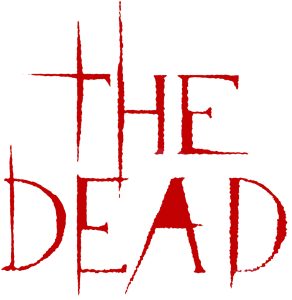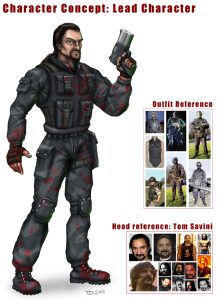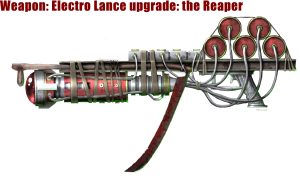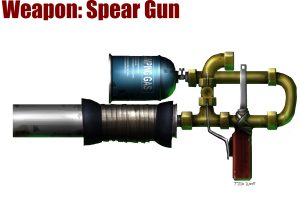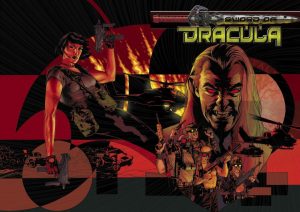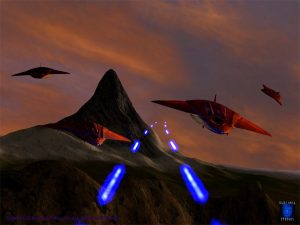City of the Dead, also known as The Living Dead : City of the Dead and George A. Romero’s City of the Dead, is a canceled horror first-person shooter developed by Kuju Entertainment and published by Hip Interactive for PC, Xbox and Playsation 2 platforms in 2005.
Presented as “the goriest game ever made”, City of the Dead was first revealed in August 2004 by none other than American McGee as his next game, wanting to sign a deal with Living Dead Productions, the company of the father of the Zombie film, George A. Romero:
“Recently, my company TMIEC partnered with Asylum Entertainment to bring to life a new Romero concept called “City of the Dead”. We’re now in the process of shopping the interactive rights to games publishers. The tagline for the product is “the goriest game ever made”.
Only a few days after that, American McGee announced that it could finally be MercurySteam Entertainment instead of Asylum developing City of the Dead:
“The guys at MercurySteam sent over a couple of cool zombie concept images. Based on what an amazing job they’ve done on Scrapland we’re really excited to have them attached to develop the Romero “City of the Dead” game.”
In December of the same year, Hip Interactive revealed to have signed a deal with Living Dead Productions about a game named City of the Dead, without saying if it was the same concept initially pitched by American McGee, or a brand new one as some media would later said that it was a different game:
“Horror fans have been searching for the ultimate experience in gaming, and we intend to deliver it to them with the tremendous creative input of legendary director, George A. Romero, and Living Dead Productions,” said Arindra Singh, President and CEO of Hip Interactive.
“This is a fantastic opportunity to share George’s work and ideas with the game buying public,” said Simon Bailey, Managing Director of Living Dead Productions. “We are very impressed with the quality of work that Hip will bring to the games. George’s fans and gamers alike will not be disappointed!”
Shortly after this announcement, media revealed that it was ultimately Kuju Entertainment that would develop it, replacing MercurySteam, which was slated for release in March 2006:
“Back in December, Hip Interactive announced it will produce games based on the work of horror director George A. Romero, creator of classic zombie-fests like Night of the Living Dead and Dawn of the Dead.
Hip Interactive has recruited developer Kuju Entertainment to produce the first of the Romero games, which is expected to appear by March of 2006.”
The game was officially announced shortly before E3 2005 in a statement from Hip Interactive:
“City of the Dead” begins as four desperate survivors escape a ravaged zombie infested city by helicopter. After making it to the remote island of Isla Mortal (N.B. : some media wrote that the name of the setting was Island of Ningun Futuro instead), an accident destroys their only means of escape. Unbeknown to them the island is home to a top secret military installation, overrun by the walking dead. Armed with an arsenal of traditional and futuristic weaponry, players must battle the living dead from dusk ’till dawn in series of abandoned locales. With split-screen co-op missions, party mode, and four-player online feature, “City of the Dead” also promises a range of multiplayer features that allow gamers to play as human or zombie.”
We also learned that Tom Savini lent his voice to one of the main characters:
“The company also revealed today that Tom Savini, star of From Dusk till Dawn and known horror makeup artist, will lend his voice and likeness to City of the Dead. Savini will play William “Red” McLean, a battle-worn ex-cop who initially lends support to the player, but will eventually be a playable character himself.”
Presented at E3 2005, the game received various previews from IGN, Gamespy and Gamespot. Thus, IGN wrote:
“Hip Games’ City of the Dead is a first-person shooter that’s “Trying to become Burnout for the shooting genre.” That’s at least according to company representatives, anyway. Judging by the short presentation we saw, it seems that City of the Dead can more accurately be described as, “a totally vicious FPS that features buckets of blood interspersed with the occasional cubic ton of tenderized brain matter.” City of the Dead does still feature some cool Burnout-like gameplay elements, though.
One of the modes within City of the Dead mimics Burnout 3’s infamous Crash Mode and tasks players with killing as many zombies as possible with a single shot from a specific weapon. To do this, players will want to wait for the most opportune moment to fire their weapon at one of a number of preset environmental hazards, be they massive crates suspended from cranes or conveniently placed combustible barrels. Once you shoot, the widely used Havok physics systems will take care of the rest. This way the results of the action are always different.
In terms of an actual story mode, City of the Dead features one city, some animated dead people who are terribly reluctant to stop moving, and a few dudes who’d really like to not become one of them.
In a way, City of the Dead sort of resembles a cross between Resident Evil and Soldier of Fortune. That is, the game features an excessive amount of dismemberment and gore, which it is not at all afraid to highlight with a number of cinematic, slow-mo camera swoops, zooms and pans. But unlike Soldier of Fortune, the enemies just keep on coming.
Before we go, check out this cool thing we noticed that most people might overlook… When you shoot an enemy, he is entirely governed by physics, meaning he’ll flop around like any good rag doll should. But, totally unlike just about every other game under the sun, enemies in City of the Dead can actually get up and begin animating after the physics routine has initiated and played out. This is, as far as we know, a technical problem no other developer has yet been able to resolve well (at least we haven’t seen it implemented in any other game).”
Gamespot, for its part, told us:
“City of the Dead isn’t based on any specific Romero films, but it is based within the larger Dead universe. In it, you play as one of five different characters, all of which are just trying to survive in a city that has been overrun with the walking dead.
The game itself is a first-person shooter, and it really doesn’t aspire to be anything more than a fast-paced arcade shooter. You’ll find a number of different weapon types, including pistols, machine guns, grenades, and shotguns. There were a couple of unique aspects of the weapons we saw. For instance, the shotgun is fully pump-action, meaning each time you fire, you’ll have to manually reload it using the left trigger button. While that might seem a little cumbersome at first, it actually wasn’t, and it seemed to add to the intensity of the action. Another cool thing is the way you can kind of jury-rig other things onto your weapons to make them more effective in melee combat. For example, you can tie a shovel to the butt of the shotgun, making it much easier to explode a zombie’s head. The same can be done to your pistols, by taping brass knuckles to them.
Zombies tend to travel in groups, and they come in different varieties. Obviously, there’s the usual lumbering, biting, angry zombie, but we also saw a cop zombie, who continually fired a shotgun at us at random intervals and a leaper zombie, a creepy little guy who crawls around on the ground and then jumps at you. Zombies cannot be killed unless you destroy the brain, but you can knock them backward or even blow off body parts if you hit them elsewhere.
There will be 14 to 16 story missions in the game, though the story here is barely the focus. The developers used Burnout as an example of how they are really looking to make a super-arcadey, over-the-top kind of game. So a lot of the mission objectives will be appropriately focused on killing as many zombies as you can, without much worry about anything else. Once you complete the story mode, you’ll also have arcade and multiplayer modes to check out. The arcade mode works similarly to Soul Calibur’s weapon master mode. You’ll be given a series of available challenges, each with semi-arbitrary rules, like you can only use melee combat, or you have to kill a certain number of a specific type of zombie. The multiplayer will be online for up to four players and features competitive and cooperative play. The cooperative mode sounds especially cool, as during the mode, your friends can be infected. Here, you can opt to just kill your partner immediately, sparing him the change of death, or you can keep him alive long enough to help you kill some more zombies. You’ll have to be careful, however, because once they turn, they’ll come after you.”
Finally, the Gamespy preview said:
“The game’s big visual attraction is the physics engine which flings zombies realistically around based on point of impact. Naturally, this means that there will be a variety of classic weapons such as pistols, shotguns and rocket launchers to turn the zombies into so much zombie goulash. Since it takes a headshot to kill these things, the game also rewards good shots with a beautiful images of exploding heads using a slow motion “bullet-time” effect. Given how tough the zombies are, though, it’ll take more than just a steady hand to take them out, though. That’s why the environment is full of exploding things such as gas canisters, fuel drums and crates of explosives that can set off awesome chain reactions. Judicious use of these items will be vital in clearing out levels in story mode.
As much fun as story mode looks, though, it doesn’t really hold a candle to the “One-shot” levels. These are bonus levels that are unlocked as the player goes through story mode. Undoubtedly inspired by Burnout 3’s crash challenges, the “One-shot” levels puts you in an enclosed space with a bunch of zombies wandering around and a gun with only one bullet. The challenge is to pick out the correct exploding device to shoot to set off a chain reaction that will kill as many zombies as possible in as entertaining a manner as possible.
City of the Dead will sport a multiplayer mode, but rather than just offer up a vanilla deathmatch capability, the game will instead sport a four-player co-op mode that works off the strengths of the setting. If a player gets bitten once during the game (as opposed to shot or hit), that’s it, a countdown timer starts, the player dies, and turns into a zombie. That means that even though four players start the game together, eventually someone’s going to end up a zombie — and that’s where the real fun starts. Players who become zombies will respawn as new zombies when they die and start hunting those who are still alive. They get all the strengths and weakness of the undead (slow speed and incredible resilience), so the game for the zombies becomes using their brains to set up ambushes for the human players.”
Unfortunately, only 2 months after City of the Dead was revealed, Hip Interactive filed for bankruptcy:
“After failing to strike a last-minute deal to bolster its shaky finances, Hip Interactive said it has ceased operations and would close its doors completely in short order. The company said this morning that “discussions with a third party to provide interim relief in respect of the Company’s immediate financing needs were not successful.”
“The publisher had a number of high-profile games on its upcoming slate including Call of Cthulhu: Destiny’s End, George Romero’s City of the Dead, and Jackie Chan Adventures. There has been no word on which publishers are in line to pick up those and other games due from Hip.”
Only a month after the publisher’s demise, Kuju Entertainment was trying to find a new one for the game, but alas, no deal will materialize and City of the Dead vanished after this news. It was once suggested that Freeze Interactive, a Franco-Swiss publisher founded by former staffs of the European branch of Hip Interactive, had taken over the game, now titled World of the Dead, but nothing was officially confirmed, and World of the Dead disappeared very quickly without any information, just like Freeze Interactive. This rumor followed the fact that Ghost Wars, another game initially canceled with the closure of Hip Interactive, was taken over by Freeze shortly after.
Images:
Video:

